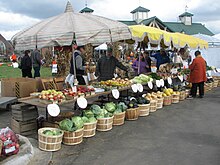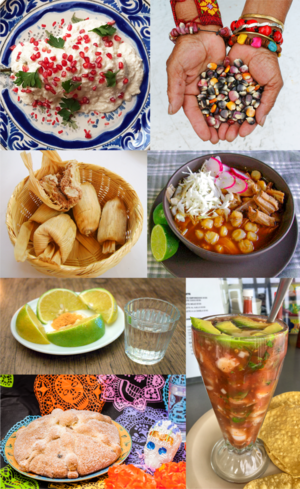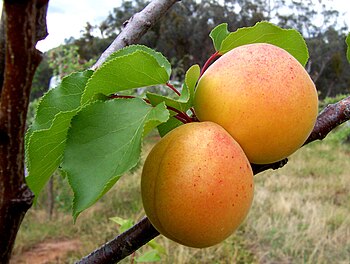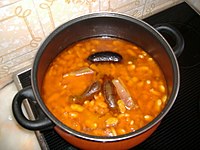Portal:Food
F o o d
A portal dedicated to food and foodways
Introduction


Food is any substance consumed by an organism for nutritional support. Food is usually of plant, animal, or fungal origin and contains essential nutrients such as carbohydrates, fats, proteins, vitamins, or minerals. The substance is ingested by an organism and assimilated by the organism's cells to provide energy, maintain life, or stimulate growth. Different species of animals have different feeding behaviours that satisfy the needs of their metabolisms and have evolved to fill a specific ecological niche within specific geographical contexts.
Omnivorous humans are highly adaptable and have adapted to obtain food in many different ecosystems. Humans generally use cooking to prepare food for consumption. The majority of the food energy required is supplied by the industrial food industry, which produces food through intensive agriculture and distributes it through complex food processing and food distribution systems. This system of conventional agriculture relies heavily on fossil fuels, which means that the food and agricultural systems are one of the major contributors to climate change, accounting for as much as 37% of total greenhouse gas emissions. (Full article...)
Cooking, also known as cookery or professionally as the culinary arts, is the art, science and craft of using heat to make food more palatable, digestible, nutritious, or safe. Cooking techniques and ingredients vary widely, from grilling food over an open fire, to using electric stoves, to baking in various types of ovens, reflecting local conditions. Cooking is an aspect of all human societies and a cultural universal.
Preparing food with heat or fire is an activity unique to humans. Archeological evidence of cooking fires from at least 300,000 years ago exists, but some estimate that humans started cooking up to 2 million years ago.
The expansion of agriculture, commerce, trade, and transportation between civilizations in different regions offered cooks many new ingredients. New inventions and technologies, such as the invention of pottery for holding and boiling of water, expanded cooking techniques. Some modern cooks apply advanced scientific techniques to food preparation to further enhance the flavor of the dish served. (Full article...)
Salade niçoise (French pronunciation: [saˈlad niˈswaz]; Occitan: salada niçarda, pronounced [saˈlaðo niˈsaɾðo], or salada nissarda in the Niçard dialect; Italian: insalata nizzarda) is a salad that originated in the French city of Nice. It is traditionally made of tomatoes, hard-boiled eggs, Niçoise olives and anchovies or tuna, dressed with olive oil, or in some historical versions, a vinaigrette. It has been popular worldwide since the early 20th century, and has been prepared and discussed by many chefs. Delia Smith called it "one of the best combinations of salad ingredients ever invented" and Gordon Ramsay said that "it must be the finest summer salad of all".
Salade niçoise can be served either as a composed salad or as a tossed salad. Freshly cooked or canned tuna may be added. For decades, traditionalists and innovators have disagreed over which ingredients should be included; traditionalists exclude cooked vegetables. The salad may include raw red peppers, shallots, artichoke hearts and other seasonal raw vegetables. Raw green beans harvested in the spring, when they are still young and crisp, may be included. However, cooked green beans and potatoes are commonly served in variations of salade niçoise that are popular around the world. (Full article...)
Selected article –

A farmers' market (or farmers market according to the AP stylebook, also farmer's market in the Cambridge Dictionary) is a physical retail marketplace intended to sell foods directly by farmers to consumers. Farmers' markets may be indoors or outdoors and typically consist of booths, tables or stands where farmers sell their produce, live animals and plants, and sometimes prepared foods and beverages. Farmers' markets exist in many countries worldwide and reflect the local culture and economy. The size of the market may be just a few stalls or it may be as large as several city blocks. Due to their nature, they tend to be less rigidly regulated than retail produce shops.
They are distinguished from public markets, which are generally housed in permanent structures, open year-round, and offer a variety of non-farmer/non-producer vendors, packaged foods and non-food products. (Full article...)Selected cuisine -

Mexican cuisine consists of the cooking cuisines and traditions of the modern country of Mexico. Its earliest roots lie in Mesoamerican cuisine. Its ingredients and methods begin with the first agricultural communities such as the Olmec and Maya who domesticated maize, created the standard process of nixtamalization, and established their foodways. Successive waves of other Mesoamerican groups brought with them their cooking methods. These included: the Teotihuacanos, Toltec, Huastec, Zapotec, Mixtec, Otomi, Purépecha, Totonac, Mazatec, Mazahua, and Nahua. With the Mexica formation of the multi-ethnic Triple Alliance (Aztec Empire), culinary foodways became infused (Aztec cuisine).
Today's food staples native to the land include corn (maize), turkey, beans, squash, amaranth, chia, avocados, tomatoes, tomatillos, cacao, vanilla, agave, spirulina, sweet potato, cactus, and chili pepper. Its history over the centuries has resulted in regional cuisines based on local conditions, including Baja Med, Chiapas, Veracruz, Oaxacan, and the American cuisines of New Mexican and Tex-Mex. (Full article...)Selected ingredient –
An apple is a round, edible fruit produced by an apple tree (Malus spp., among them the domestic or orchard apple; Malus domestica). Apple trees are cultivated worldwide and are the most widely grown species in the genus Malus. The tree originated in Central Asia, where its wild ancestor, Malus sieversii, is still found. Apples have been grown for thousands of years in Eurasia and were introduced to North America by European colonists. Apples have religious and mythological significance in many cultures, including Norse, Greek, and European Christian tradition.
Apples grown from seed tend to be very different from those of their parents, and the resultant fruit frequently lacks desired characteristics. For commercial purposes, including botanical evaluation, apple cultivars are propagated by clonal grafting onto rootstocks. Apple trees grown without rootstocks tend to be larger and much slower to fruit after planting. Rootstocks are used to control the speed of growth and the size of the resulting tree, allowing for easier harvesting. (Full article...)
Selected recipe –
French toast is a dish of sliced bread soaked in beaten eggs and often milk or cream, then pan-fried. Alternative names and variants include eggy bread, Bombay toast, gypsy toast, and poor knights (of Windsor).
When French toast is served as a sweet dish, sugar, vanilla, or cinnamon are also commonly added before pan-frying, and then it may be topped with sugar (often powdered sugar), butter, fruit, or syrup. When it is a savory dish, it is generally fried with a pinch of salt or pepper, and it can then be served with a sauce such as ketchup or mayonnaise. (Full article...)
Elizabeth David CBE (born Elizabeth Gwynne, 26 December 1913 – 22 May 1992) was a British cookery writer. In the mid-20th century she strongly influenced the revitalisation of home cookery in her native country and beyond with articles and books about European cuisines and traditional British dishes.
Born to an upper-class family, David rebelled against social norms of the day. In the 1930s she studied art in Paris, became an actress, and ran off with a married man with whom she sailed in a small boat to Italy, where their boat was confiscated. They reached Greece, where they were nearly trapped by the German invasion in 1941, but escaped to Egypt, where they parted. She then worked for the British government, running a library in Cairo. While there she married, but she and her husband separated soon after and subsequently divorced. (Full article...)Selected image –
Selected biography –
B. 1618 – d. 1678
François Pierre de la Varenne (French pronunciation: [fʁɑ̃swa pjɛʁ də la vaʁɛn], 1615–1678 in Dijon), Burgundian by birth, was the author of Le Cuisinier françois (1651), one of the most influential cookbooks in early modern French cuisine. La Varenne broke with the traditions that had revolutionised medieval and Renaissance French cookery in the 16th century and early 17th century. (Full article...)
Did you know (auto-generated) –

- ... that John Bunker was inspired to propagate old apple tree varieties after encountering Black Oxford apples while managing the food co-op in Belfast, Maine?
- ... that the Sonoran blue butterfly uses Dudleya cymosa subsp. pumila as a larval foodplant and hummingbirds feed on its nectar?
- ... that Turkish migrant workers living in a residential complex in Amsterdam refused to eat the Dutch food for two weeks after the kitchen's only Turkish chef was fired?
- ... that because of the increasing prevalence of sesame allergy, the U.S. will join the EU and Canada in 2023 in instituting mandatory food labeling?
- ... that the vegan-food brand Squeaky Bean produces food that does not contain beans?
- ... that before Angeli Foods was sold this year, the first self-service grocery store in the Upper Peninsula of Michigan had been owned by three generations of a single family?
More did you know –
Related portals
Food topics
The following are topics relating to food
Categories
Food list articles
- See also: Lists of foods and Category:Lists of drinks
The following are some Food list articles on Wikipedia:

- American cheeses
- Appellation d'Origine Contrôlée cheeses
- Apple cultivars
- Bacon dishes
- Bacon substitutes
- Basil cultivars
- Breads
- Breakfast beverages
- Breakfast cereals
- Breakfast foods
- British cheeses
- Cakes
- Candies
- Cheeses
- Cheese soups
- Christmas dishes (list)
- Cocktails
- Cookies
- Dishes using coconut milk
- Diets
- Doughnut varieties
- Egg dishes
- Fermented soy products
- Food additives
- Food additives (Codex Alimentarius)
- Foods named after people
- French cheeses
- French dishes
- Fried dough foods
- Fruits
- List of hamburgers
- Herbs and spices
- Hors d'oeuvre
- Indian dishes
- Indian snack foods
- Indonesian dishes
- Italian dishes
- Japanese snacks
- Japanese dishes
- Jewish dishes
- Kebabs
- Korean beverages
- Mango cultivars
- Moroccan dishes
- Pasta
- Pastries
- Philippine snack food
- Pies, tarts and flans
- Poppy seed pastries and dishes
- Potato dishes
- Puddings
- Raw fish dishes
- Rice dishes
- Rolled foods
- Sauces
- Seafood
- Seeds
- Sandwiches
- Snack foods
- Soft drinks by country
- Soul foods and dishes
- Soups
- Stews
- Street foods
- Tapas
- Turkish dishes
- Twice-baked foods
- Vegetable oils
- Vegetables
- Vodkas
Things you can do
Related WikiProjects
| Parent project: WikiProject Food and Drink | |
| Child projects: | Task forces: (All inactive) |
|
|
| Related projects: | |
New articles
Rules | Match log | Results page (for watching) | Last updated: 2024-05-18 19:24 (UTC)
Note: The list display can now be customized by each user. See List display personalization for details.
- Joyride Sweets (edit | talk | history | links | watch | logs | tools) by Bennett1203 (talk · contribs · new pages (20)) started on 2024-05-18, score: 40
- Khanom Med Khanoon (edit | talk | history | links | watch | logs | tools) by Quantplinus (talk · contribs · new pages (1)) started on 2024-05-18, score: 10
- Tony Connor (musician) (edit | talk | history | links | watch | logs | tools) by Anavatar (talk · contribs · new pages (5)) started on 2024-05-18, score: 10
- Patrick Olive (edit | talk | history | links | watch | logs | tools) by Anavatar (talk · contribs · new pages (5)) started on 2024-05-18, score: 10
- Taquería El Califa de León (edit | talk | history | links | watch | logs | tools) by Tbhotch (talk · contribs · new pages (23)) started on 2024-05-18, score: 10
- Harvey Hinsley (edit | talk | history | links | watch | logs | tools) by Anavatar (talk · contribs · new pages (5)) started on 2024-05-17, score: 10
- Fulcrum Coffee (edit | talk | history | links | watch | logs | tools) by Another Believer (talk · contribs · new pages (93)) started on 2024-05-17, score: 10
- Kutach (edit | talk | history | links | watch | logs | tools) by PiMaster3 (talk · contribs · new pages (3)) started on 2024-05-16, score: 20
- White Rhino Coffee (edit | talk | history | links | watch | logs | tools) by Blizzleduh (talk · contribs · new pages (1)) started on 2024-05-15, score: 10
- On2Cook (edit | talk | history | links | watch | logs | tools) by Roadrazer84 (talk · contribs · new pages (1)) started on 2024-05-15, score: 10
- MDH and Everest global safety concerns (edit | talk | history | links | watch | logs | tools) by Sherenk1 (talk · contribs · new pages (1)) started on 2024-05-15, score: 20
- Domoda (edit | talk | history | links | watch | logs | tools) by Monomi0 (talk · contribs · new pages (1)) started on 2024-05-14, score: 10
- Egg Yolkeo (edit | talk | history | links | watch | logs | tools) by A.S. Brown (talk · contribs · new pages (10)) started on 2024-05-11, score: 20
- Magical Golden Singing Cheeses (edit | talk | history | links | watch | logs | tools) by A.S. Brown (talk · contribs · new pages (10)) started on 2024-05-11, score: 10
- Kōji (food) (edit | talk | history | links | watch | logs | tools) by Ghilt (talk · contribs · new pages (4)) started on 2024-05-13, score: 10
- Koji (food) (edit | talk | history | links | watch | logs | tools) by Ghilt (talk · contribs · new pages (4)) started on 2024-05-13, score: 10
- Half and Half Doughnut Co. (edit | talk | history | links | watch | logs | tools) by Another Believer (talk · contribs · new pages (93)) started on 2024-05-13, score: 10
- Williams and Woods (edit | talk | history | links | watch | logs | tools) by GeneralBelly (talk · contribs · new pages (3)) started on 2024-05-12, score: 10
- Thamnaconus hypargyreus (edit | talk | history | links | watch | logs | tools) by Primium (talk · contribs · new pages (6)) started on 2024-05-12, score: 10
- Akbar Mirza Khaleeli (edit | talk | history | links | watch | logs | tools) by Bingchungus (talk · contribs · new pages (2)) started on 2024-05-12, score: 10
- Garry Kennebrew (edit | talk | history | links | watch | logs | tools) by AllWeKnowOfHeaven (talk · contribs · new pages (3)) started on 2024-05-06, score: 10
- Demonstration kitchen (edit | talk | history | links | watch | logs | tools) by Whoisjohngalt (talk · contribs · new pages (2)) started on 2024-05-12, score: 20
- China in Box (edit | talk | history | links | watch | logs | tools) by Vitorperrut555 (talk · contribs · new pages (1)) started on 2024-05-12, score: 20
- Chinatown Ice Cream Factory (edit | talk | history | links | watch | logs | tools) by ForsythiaJo (talk · contribs · new pages (76)) started on 2024-05-11, score: 10
- Pepsi AM (edit | talk | history | links | watch | logs | tools) by Tatsnorad (talk · contribs · new pages (2)) started on 2024-05-11, score: 20
- South Bend Chocolate Company (edit | talk | history | links | watch | logs | tools) by CusterDome (talk · contribs · new pages (1)) started on 2024-05-11, score: 10
- Hey Chicken! (edit | talk | history | links | watch | logs | tools) by Luvcraft (talk · contribs · new pages (1)) started on 2024-05-11, score: 10
- Ko Omm (edit | talk | history | links | watch | logs | tools) by Sattwaikyaw (talk · contribs · new pages (1)) started on 2024-05-11, score: 10
- Soumaintrain (cheese) (edit | talk | history | links | watch | logs | tools) by WillBanz (talk · contribs · new pages (1)) started on 2024-05-11, score: 20
- SugarBun (edit | talk | history | links | watch | logs | tools) by The Bangsawan (talk · contribs · new pages (3)) started on 2024-05-11, score: 10
- List of whisky brands in England (edit | talk | history | links | watch | logs | tools) by ChefBear01 (talk · contribs · new pages (4)) started on 2024-05-10, score: 20
- Donut Factory (edit | talk | history | links | watch | logs | tools) by Another Believer (talk · contribs · new pages (93)) started on 2024-05-10, score: 10
- Causa (restaurant) (edit | talk | history | links | watch | logs | tools) by Another Believer (talk · contribs · new pages (93)) started on 2024-05-10, score: 10
- Rania (restaurant) (edit | talk | history | links | watch | logs | tools) by Another Believer (talk · contribs · new pages (93)) started on 2024-05-10, score: 10
- Adams Oyster Company (edit | talk | history | links | watch | logs | tools) by DMVHistorian (talk · contribs · new pages (14)) started on 2024-05-10, score: 10
- Spaghetti alla siracusana (edit | talk | history | links | watch | logs | tools) by JackkBrown (talk · contribs · new pages (3)) started on 2024-05-09, score: 10
- Puffed rice cakes (edit | talk | history | links | watch | logs | tools) by 2003:CA:8718:D68F:4AEE:DFFA:5B34:E259 (talk · contribs · new pages (1)) started on 2024-05-09, score: 30
- Osmotherium (edit | talk | history | links | watch | logs | tools) by LaraPoasting (talk · contribs · new pages (4)) started on 2024-05-09, score: 10
- Fresh Thyme (edit | talk | history | links | watch | logs | tools) by 96.69.249.93 (talk · contribs · new pages (2)) started on 2024-05-09, score: 10
- Chicago Steak Company (edit | talk | history | links | watch | logs | tools) by AbrilTheCarpenter (talk · contribs · new pages (2)) started on 2024-05-09, score: 20
- Nikolay Vereshchagin (edit | talk | history | links | watch | logs | tools) by Kolya Muratov (talk · contribs · new pages (3)) started on 2024-05-07, score: 10
- Cardinal slice (edit | talk | history | links | watch | logs | tools) by Pek (talk · contribs · new pages (20)) started on 2024-05-07, score: 10
- Big Potato Man (edit | talk | history | links | watch | logs | tools) by B3251 (talk · contribs · new pages (27)) started on 2024-05-06, score: 10
- 2024–25 West Ham United F.C. season (edit | talk | history | links | watch | logs | tools) by Egghead06 (talk · contribs · new pages (5)) started on 2024-05-06, score: 10
- Tarte à l'badrée (edit | talk | history | links | watch | logs | tools) by Frankserafini87 (talk · contribs · new pages (4)) started on 2024-05-06, score: 20
- Café Avole (edit | talk | history | links | watch | logs | tools) by Another Believer (talk · contribs · new pages (93)) started on 2024-05-05, score: 10
- Subric (edit | talk | history | links | watch | logs | tools) by Frankserafini87 (talk · contribs · new pages (4)) started on 2024-05-05, score: 10
- Association of Estonian Food Industry (edit | talk | history | links | watch | logs | tools) by Estopedist1 (talk · contribs · new pages (10)) started on 2024-05-05, score: 20
- Ghost Note Coffee (edit | talk | history | links | watch | logs | tools) by Another Believer (talk · contribs · new pages (93)) started on 2024-05-05, score: 10
- Integrated Aqua-Vegeculture System (edit | talk | history | links | watch | logs | tools) by Wiki142B (talk · contribs · new pages (1)) started on 2024-05-05, score: 10
- Bark City BBQ (edit | talk | history | links | watch | logs | tools) by Another Believer (talk · contribs · new pages (93)) started on 2024-05-04, score: 10
Associated Wikimedia
The following Wikimedia Foundation sister projects provide more on this subject:
-
Commons
Free media repository -
Wikibooks
Free textbooks and manuals -
Wikidata
Free knowledge base -
Wikinews
Free-content news -
Wikiquote
Collection of quotations -
Wikisource
Free-content library -
Wikiversity
Free learning tools -
Wiktionary
Dictionary and thesaurus

















































